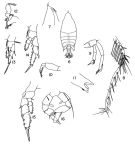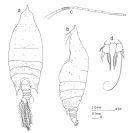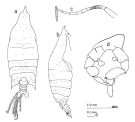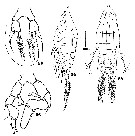|
|
 |
Fiche d'espèce de Copépode |
|
|
Calanoida ( Ordre ) |
|
|
|
Arietelloidea ( Superfamille ) |
|
|
|
Arietellidae ( Famille ) |
|
|
|
Arietellus ( Genre ) |
|
|
| |
Arietellus aculeatus (T. Scott, 1894) (F,M) | |
| | | | | | | Syn.: | Rhincalanus aculeatus T. Scott,1894 b (p.31, Descr.F, figs.F);
? Arietellus armatus Wolfenden, 1911 (p.330, figs.F); C.B. Wilson, 1950 (p.165, Pl.4, figs.23-26: F,M); no Farran, 1929 (p.270, Rem.);
? A. aculeatus : A. Scott, 1909 (p.143, figs.F); ? Farran, 1929; Grice, 1961 (1962) (p.226, figs. juv.F); Paiva, 1963 (p.62, figs.F,M) | | | | Ref.: | | | Grice, 1962 (p.226, figs F juv.); Vervoort, 1965 (p.150, Rem.); Park, 1968 (p.564, Descr.M, figs.M, Rem.); Bradford, 1974 a (p.526, figs.F,M, Rem.); Ohtsuka & al., 1994 (p.130, Redescr.F,M, figs.F,M); Bradford-Grieve & al., 1999 (p.881, 937, figs.F,M) |  Issued from : T.S. Park in Fishery Bull. Fish Wild. Serv. U.S., 1968, 66 (3). [p.565, Pl.12, Figs.6-16]. Male: 6, habitus (dorsal); 7, forehead (right lateral side); 8, left A1; 9, A2; 10, Md (mandibular palp); 11, Md (masticatory edge); 12,Mx1; 13, P1; 14, P2; 15, P4; 16, P5 (posterior).
|
 issued from : J.M. Bradford-Grieve in The Marine Fauna of New Zealand: Pelagic Calanoid Copepoda. National Institute of Water and Atmospheric Research (NIWA). NIWA Biodiversity Memoir, 111, 1999. [p.31, Fig.9]. Female (stage V): A, habitus (dorsal); B, idem (left lateral side); C, P5 (L = left leg; R = right leg). Male: D, habitus (dorsal); E, P5. Nota:
|
 issued from: J.M. Bradford in N.Z. Jl mar. freshw Res., 1974, 8 (3). [p.527, Fig.3]. Female: a, habitus (dorsal); b, idem (lateral left side); c, A1; d, P5. Nota: The distribution pattern of integumental organs are recorded here as accurately as possible.
|
 issued from: J.M. Bradford in N.Z. Jl mar. freshw Res., 1974, 8 (3). [p.529, Fig.4]. Male: a, habitus (dorsal); b, idem (lateral right side); c, A1; d, P5. Nota: The distribution pattern of integumental organs are recorded here as accurately as possible.
|
 issued from : S. Ohtsuka, G.A. Boxshall & H.S.J. Roe in Bull. nat. Hist. Lond. (Zool.), 1994, 60 (2). [p.132, Fig.16, F-G]. 2nd endopod segment of A2: G, Female; F, Male. Scale bar in mm. Nota: 2nd endopod segment with 2 short inner setae medially and 5 setae and 1 vestigial seta terminally in female; 1 long and 1 short seta medially in male.
|
 issued from : S. Ohtsuka, G.A. Boxshall & H.S.J. Roe in Bull. nat. Hist. Lond. (Zool.), 1994, 60 (2). [p.134, Fig.18, D,E,O]. Female: D, 1st exopod segment of Md. Nota: Mandibular palp with 1st exopod segment with reduced, short seta. Male: E, 1st exopod segment of Md; 0, left endopod of P5. Nota: Mandibular palp with 1st exopod segment with well-developed seta. Endopod of Mx1 almost fused with basis, represented by small knob. Left endopod of P5 indistinctly 2-segmented, with suture visible on posterior surface; compound distal exopod segment of right leg with minute terminal element Scale bars in mm.
|
 issued from : A. Scott in Siboga-Expedition, 1909, XIX a. [Plate XLIV, Figs.4-7]. With doubt (perhaps juvenile). Female (from Halmahera Sea): 4, habitus (dorsal); 5, forehead (lateral); 6, last thoracic and genital segments (left side); 7, P5.
|
 issued from : C.B. Wilson in Bull. U.S. Natn. Mus., 1950, 100, 14 (4). [Pl.4, Figs.23-26]. As Arietellus armatus. Female (from 8°04'N, 52°04'N): 23-24, habitus (dorsal and lateral, respectively); 25, P5. Nota: Endopod of A2 a little longer than exopod. Md palp uniramose with endopod entirely lacking. Genital segment wider than long and not protruding ventrally, with nearly straight sides. Anal segment incised posteriorly. Caudal rami at the corners of the anal segment and divergent, each a little longer than wide and with 5 stout setae, the 3 middle setae much longer than the other two, plumose, the outer seta at the middle of the outer margin. P5 uniramose and 3-segmented; their basal segments fused across the midline, the two plumose setae on the inner corners of the 2nd segments and the appendicular filiform seta on the right leg exceptionally long; the 3rd segments are nearly as long as the other two combined, slightly swollen at the base and tapered into long acuminate points. Male: P5. Nota: Left A1 geniculate. P5 asymmetrical, the right one longer and stouter than the left, with two curves giving it an S shape; the first two segments of exopod with spines at their outer distal corners, long, slender and acuminate; the 2nd segment also has a short and stout spine on the surface at the distal end just inside the inner margin; the terminal segment is nearly 3 times as long as wide, bluntly rounded at its tip and without any spines or setae; right endopod apparently 2-segmented and attached to the inner margin of the basipod near the distal end. The first two segments of the left leg also carry spines at the outer distal corner, stouter than those on the right leg and slightly curved, and in addition the 2nd segment has a sinuous distal margin; the terminal segment is armed with 3 fingerlike processes, 1 on the outer margin near the base and 2 unequal in size at the tip; the left endopod is 1-segmented, and its enlarged tip is bilobed; like the right endopod, it is attached not to the end of the basipod but on the inner margin.
| | | | | Ref. compl.: | | | Sewell, 1948 (p.350, 523, 548, 550); De Decker & Mombeck, 1964 (p.11); Morris, 1970 (p.2301); Lakkis, 1976 (p.83, Rem.); Dessier, 1979 (p.206); Stephen & Rao, 1980 (p.242); Guangshan & Honglin, 1984 (p.118, tab.); Moraitou-Apostolopoulou, 1985 (p.303, occurrence/abundance in E Mediterranean Sea, Rem.: p.313); Shih & Young, 1995 (p.67); Schnack-Schiel & al., 2010 (p.2064, Table 2: E Atlantic subtropical/tropical); Teuber & al., 2013 (p.1, Table 1, 2, abundance vs oxygen minimum zone, respiration rates); | | | | NZ: | 11 | | |
|
Carte de distribution de Arietellus aculeatus par zones géographiques
|
| | | | | | | | | | | |  issued from : R. Stephen & T.S.S. Rao in J. Plankton Res., 1980, 2 (2). [p.242, Fig.1]. issued from : R. Stephen & T.S.S. Rao in J. Plankton Res., 1980, 2 (2). [p.242, Fig.1].
Distribution of Arietellus and Paraugaptilus in the Indian Ocean (open circles indicate the stations selected for the study). |
| | | | Loc: | | | South Africa (E), SE Atlantic, Angola, Congo, G. of Guinea, Cape Verde Is., off Barbada, E Medit. (Lebanon), Indian, Halmahera Sea, Indonesia-Malaysia, Philippines, China Seas (South China Sea), Pacif. (W equatorial), off NW New Zealand, off Hawaii (S, N & NE) | | | | N: | 23 | | | | Lg.: | | | (5) F: 4,53; (16) F: 5-4,63; M: 4,08; (71) F: 4,62; M: 3,79-3,77; (72) M: 3,6; (73) F: 4,99; M: 4,62-4,36; (74) F: 4,27-3,45; M: 3,82; (137) ? F: 5,20; M: 4,21; {F: 3,45-5,00; M: 3,60-4,62} | | | | Rem.: | mésopélagique.
Les divers auteurs ne sont pas en accord sur les synonymes.
Voir aussi les remarques en anglais | | | Dernière mise à jour : 22/01/2020 | |
|
|
 Toute utilisation de ce site pour une publication sera mentionnée avec la référence suivante : Toute utilisation de ce site pour une publication sera mentionnée avec la référence suivante :
Razouls C., Desreumaux N., Kouwenberg J. et de Bovée F., 2005-2026. - Biodiversité des Copépodes planctoniques marins (morphologie, répartition géographique et données biologiques). Sorbonne Université, CNRS. Disponible sur http://copepodes.obs-banyuls.fr [Accédé le 18 janvier 2026] © copyright 2005-2026 Sorbonne Université, CNRS
|
|
 |
 |












